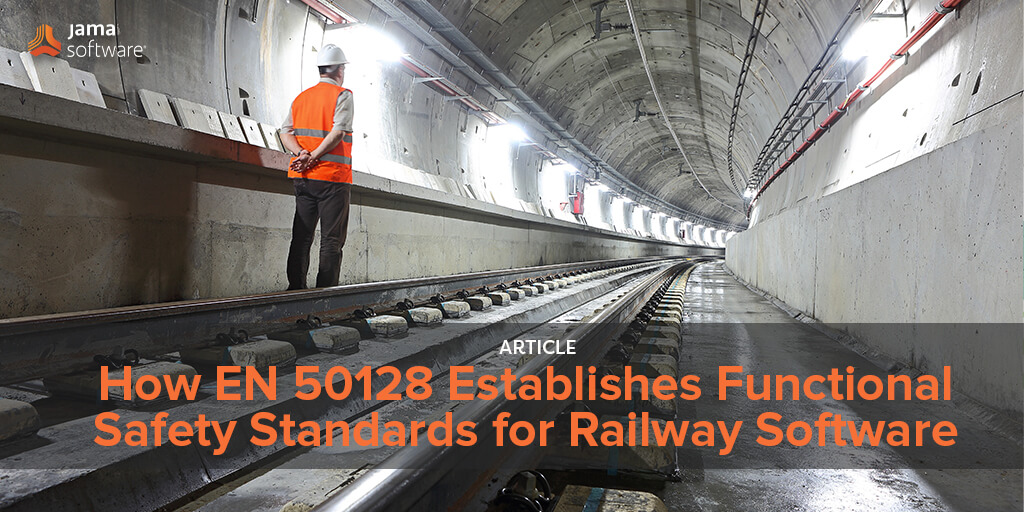
How EN 50128 Establishes Functional Safety Standards for Railway Software
In increasingly complex, rapidly evolving, and highly regulated industries, product development teams must build safety-critical products, while streamlining risk management and keeping accuracy and security at the forefront. This blog post will define functional safety and EN 50128 and explain why compliance with safety standards is critical to railway software and industrial manufacturing teams.
What is Functional Safety?
As part of the overall safety of a system or piece of equipment, functional safety is a key component that builds upon automatic protection. The best way to reduce risks in industrial manufacturing is to ensure automated protection systems have predictable responses to malfunctions or failures.
The concept of functional safety applies to everyday life and every industry you can think of. The International Electrotechnical Commission (IEC) provides this example of transportation functional safety:
“When you board a train, the subway or a cable car, functional safety ensures that the doors close before the vehicle departs and that they don’t open while it is in movement. They also ensure that the railway signaling system helps avoid that an oncoming train crosses your train’s path.”
When systems fail to operate, significant disasters can occur. Safety standards, such as EN 50128, are designed to reduce risk tolerance around these events.
What is EN 50128?
EN 50128 is a certification standard issued by CENELEC (the European Committee for Electrotechnical Standardization). The international version of this standard is IEC 62279. This standard specifies the requirements for railway applications, including communication, signaling, and processing systems for railway control and protection systems software.
RELATED: IEC 61508 Overview: The Complete Guide for Functional Safety in Industrial Manufacturing
According to Engineering360, the European standard “specifies the process and technical requirements for the development of software for programmable electronic systems for use in railway control and protection applications.” It aims toward any practical use where there are safety implications. This European Standard applies exclusively to software, the interaction between software and its system, and all safety-related software used in railway control and protection systems, including:
- Application programming
- Operating systems
- Support tools
- Firmware
Why compliance with safety standards such as EN 50128 is critical to railway software and industrial manufacturing teams
Eliminating all chances of risk may not always be possible. However, manufacturers must continuously seek strategies to mitigate potential safety issues, which is why industry experts in industrial manufacturing have created standards, such as EN 50128, and IEC 62279, to reduce risk and support the development of safety-sensitive products.
According to TUV SUD, “functional safety ensures that safety risks due to hazards caused by the mal-functional behavior of systems are reduced to an acceptable level. These safety risks are increasing in the rail industry as rail technology is becoming more and more complex, with both hardware and software interacting in different ways and components that are sourced from multiple markets.”
RELATED: The Top Six Things You Should Know About TÜV SÜD
How Jama Connect® Can Help Organizations Achieve EN 50128 Compliance
Compliance is an essential goal for organizations in regulated industries, but it is not the only factor when delivering safe and reliable products to market. Organizations need defined processes for development and production and detailed end-to-end traceability to achieve compliance, from high-level user needs to validation and verification.
Jama Connect® is TÜV SÜD certified for developing safety-related products. Jama Software® is the first vendor that is both SaaS and Agile to receive the certification. In 2019, Jama Software completed additional certification as a software tool for railway applications according to EN 50128.
Focus and rigor in the product development lifecycle drives compliance as an outcome. While the ultimate responsibility of functional safety remains with the customer, Jama Connect eases the path to compliance so companies can focus on building products right.
Ensuring Compliance & Managing Risk with Jama Connect
Jama Connect is engineered to ensure quality with frameworks aligned to key industry standards which streamline design, development, testing, and risk management while maintaining compliance. Teams can quickly see the full historical context around a requirement when they contribute to a project — reducing the probability of errors as well as the time and overhead spent on risk analysis.
Interested in learning more? Watch our webinar, Lessons Learned for Reducing Risk in Product Development
- 2023 Predictions for Medical Device Product Development - December 22, 2022
- 2023 Predictions for Industrial and Consumer Electronics Product Development - December 15, 2022
- Euro Roundup: MDCG Publishes Guidance on MDR, IVDR Authorized Representative Requirements - December 12, 2022